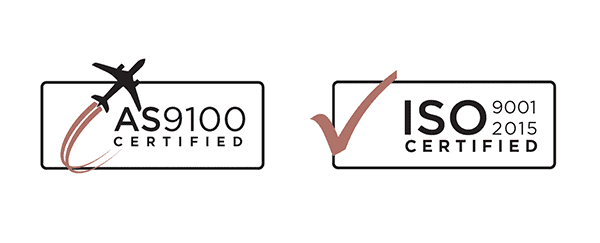For those who are not well-versed, AS9100D is an international quality management standard that meets the exceptional requirements of the aerospace industry. It is an extension of the standards within ISO 9001. Subject to periodic audits, it is a prerequisite for any manufacturer, contractor or subcontractor looking to gain a foothold in aviation, space or defense organizations. Which is exactly what we were looking to do when we opted to get registered for AS9100D, in addition to our ISO 9001:2015 certification.
ISO 9001, the Foundation of AS9100D
It’s good to know that the extended title is “AS9100D Quality Management Systems — Requirements for Aviation, Space and Defense Organizations.” As the AS9100D builds on the standards already imposed by ISO 9001, one cannot define the former without also defining the latter.
Developed by the International Organization for Standardization (ISO), ISO 9001 is a quality management system (QMS) designed for the manufacturing and service industries. Like any QMS, ISO 9001 establishes standards for identifying, measuring, and improving core business processes that improve customer satisfaction and business performance.
ISO 9001 does not define “quality” — it provides a path for organizations looking to refine their methods of delivering it. In essence, an organization must demonstrate how their processes will comply to the extensive standards within ISO 9001. These standards are built upon seven quality principles, although the exact methods of achieving them will vary between organizations.
- Customer focus: Identify customers’ needs and measure their satisfaction.
- Leadership: Demonstrate and maintain top-level commitment to effective methods of quality management.
- Engagement of people: Train and engage every employee regardless of level.
- Process approach: Establish and refine clear processes to deliver and improve quality.
- Improvement: Establish and maintain a top-down commitment to continuous improvement.
- Evidence-based decision making: Collect and analyze data to guide corrective actions.
- Relationship management: Partner with suppliers and other parties with a shared interest in cost management, optimization and quality.
ISO 9001 certification is no small feat, and requires significant planning, delegation and training throughout an organization. To be certified, an organization must pass an audit by an accredited certification body (CB) or registrar. Organizations must re-certify every three years to maintain their certification.
Requirements Specific to AS9100D
AS9100D includes all of the content from the ISO 9001 and inserts additional requirements that meet the needs of the aerospace industry. It is maintained by the Aerospace division of SAE International and the International Aerospace Quality Group (IAQG), and these additions were developed to meet NASA, DOD and FAA quality requirements. For easy reference, each requirement specific to AS9100D is in bold italics.
The scope of these additions primarily involve risk management as it relates to product safety and counterfeit parts. As one might expect, due to the higher stakes of aerospace, risk-tolerance is much lower than the requirements within ISO 9001.
The initial certification is a prolonged process designed to expose and remedy any and all areas of non-compliance within an organization. The first assessment is a readiness audit and provides an action plan for the organization undergoing the audit; the second audit confirms the organization’s compliance for full certification. Organizations have up to six months to correct any shortcomings, after which they must initiate another assessment to proceed further.
Like ISO 9001, AS9100D requires periodic audits to maintain certification. Like ISO 9001, AS9100D re-certification is completed every 3 years (with annual audits conducted to tract compliancy. We can attest to the fact that becoming AS9100D was an all-hands-on-deck effort for our team, although the additional process controls has been beneficial to clients in many other industry segments.
Summary of AS9100D Additions
Below is a list of the most significant additions to ISO 9001 requirements. AS9100D does not delete any existing requirements, and provides additional requirements relating to:
- Production Control
- Verification of production equipment and processes
- Control of changes to equipment and processes
- Post-delivery support and controls on production equipment
- Product preservation and shelf-life control
- Planning for Product Realization
- Project management, risk management, configuration management
- Control of work transfers between facilities, to suppliers or between suppliers
- Pervasive risk identification and risk assessment
- Design and Development
- Verification and validation
- Testing
- Documentation
- Purchasing and Purchased Product
- Supplier control
- Information sent to suppliers
- Product purchased for use in a controlled or limited way
- Non-conforming processes
- Product monitoring and measurement
- Criteria for rejection and special measurement instructions
- Corrective action, including flow down of corrective action to suppliers
AS9100D at Oil & Gas Industry Parts China
At Oil & Gas Industry Parts China, auditors from NSF International oversaw our transition from ISO9001:2008 to AS9100D and ISO9001:2015 in 2018, although we’ve been ISO9001 certified since 2000.
Although this certification was added specifically to meet the needs of our aerospace and defense industry clients, the rigorous quality methodology and process standards of AS9100D certification have improved our ability to meet the requirements of all our customers. No matter what industry — whether aerospace, medical, industrial or one of the many others we service —we take the quality requirements and specifications seriously and as a significant contribution to the success of our clients.
For more information on our Quality Systems, you can check out the Quality Page on our website, or Contact Us for more information. Follow us LinkedIn, Instagram, Facebook, and Twitter to hear about additional certifications we’ll be adding in early 2020.



